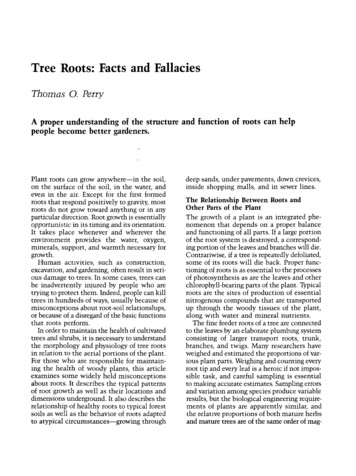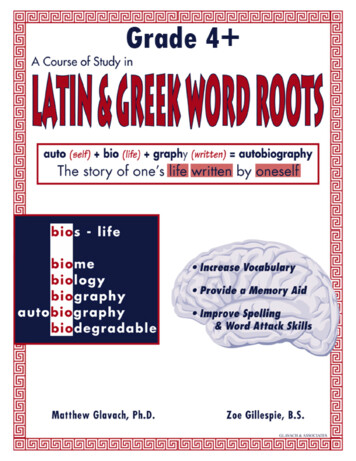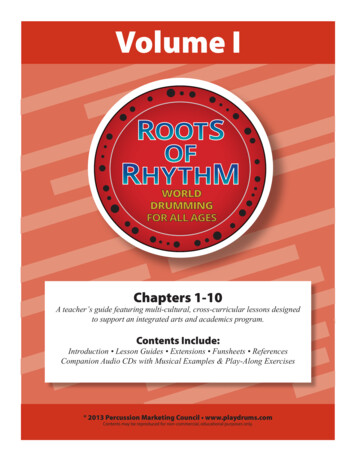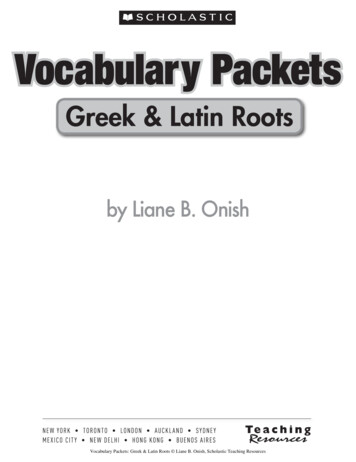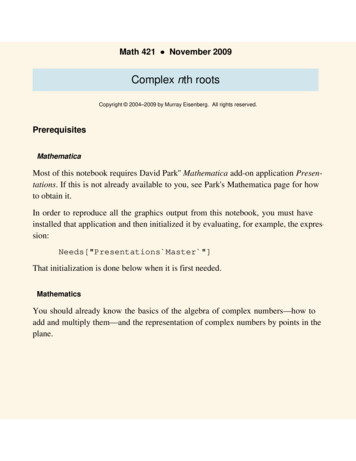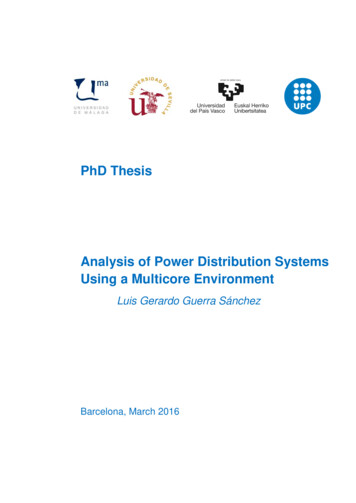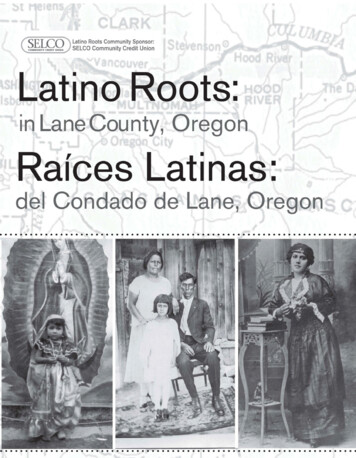
Transcription
Distribution of Roots andRhizomes in Different SoilTypes in the Pine Barrensof New JerseyGEOLOGICALSURVEYPROFESSIONALPrepared in cooperation with the New JerseyDepartment of Conservation and EconomicDevelopment Division of Water Policy andSupply; Rutgers University; and the U. S.Forest ServicePAPER563-C
Distribution of Roots andRhizomes in Different SoilTypes in the Pine Barrensof New JerseyBy WILLIAM A. LAYCOCKHYDROLOGY LNEW JERSEYPAPER563-CPrepared in cooperation with the New JerseyDepartment of Conservation and EconomicDevelopment, Division of Water Policy andSupply; Rutgers University; and the U. S.Forest ServiceUNITED STATES GOVERNMENT PRINTING OFFICE, WASHINGTON : 1967
UNITED STATES DEPARTMENT OF THE INTERIORSTEW ART L. UDALL, SecretaryGEOLOGICAL SURVEYWilliam T. Pecora, DirectorFor sale by the Superintendent of Documents, U.S. Government Printing OfficeWashington, D.C. 20402 - Price 30 cents (paper cover)
CONTENTSDefinition of botanical termsAbstract .Introduction.Purpose and scope ------ - .Acknowledgments.Location and general features of the area.Previous studies.Methods used to study root systems.Root and rhizome systems.Vertical distribution of roots-Root and rhizome systemsRoots and rhizomes of the most common shrubs- Upland shrubsGaylussacia baccata (black huckleberry)Vaccimum vacillans (lowbush blueberry)Quercus ilicifolia (scrub oak)Quercus marilandica (blackjack oak)Quercus prinoides (dwarf chestnut oak)Gaultheria procumbens (teaberry)Transition zone shrubs.Kalmia angustifolia (sheep laurel)- ---Clethra alnifoUa (sweet pepperbush)Lyonia mariana (staggerbush)Gaylussacia frondosa (dangleberry)Myrica pensylvanica (bayberry)Ilex glabra (inkberry)Roots and rhizomes of less common shrubsKalmia latifolia (mountain-laurel)Hudsonia ericoides (golden heather) and Leiophyllum buxifolium (sand myrtle)Lyonia liguslrina (maleberry)Comptonia peregrina var. asplenifolia (sweetfern)Vaccinium angustifolium (low sweet blueberry)Amelanchier canadensis (serviceberry) and Pyrusmelanocarpa (black Underground rhiz ome growing tipsSeedlings - - - -- ---- - --- -Relation of root distribution to different soil types.Soil d sand 9706. .Lakewood sand, clay substratum variant 9A16Downer sand, leached phase 9E16.Lakeland sand, leached A2 phase 9Y16Lakehurst sand 9726Lakehurst sand, thick A2 variant (grading toward Leon sand)Leon sand 9736 .Additional sites: Lakewood sand 9706Additional site: Leon sand 9736Development of roots.Number and area of roots in the profile-Number and area of roots in the varioushorizons. - ----- AQ horizon. - - --- ------- --- --AI horizon.- --- ---- ----------------A2 horizonBI horizon. - ------ -----------------B2 and other lower horizons.Distribution of roots in different vegetationtypes - - - - --- ----Distribution of roots in 6-inch layers - -Distribution of roots of different sizes and types.Roots of different sizes.Roots of different typesEffect of decaying roots in the soil.Effect of soil texture on root distribution.Relation of root distribution to the water table.Effects of fire---.--------------------------------Effects on roots and rhizomes - - - -- Effects on ground-water suppliesSummary. --- - - - ----- - Selected 1718181919192020202121222424242627
IVCONTENTSILLUSTRATIONSFIGURE 1. Map of New Jersey showing the Pine Barrens and area of this report2-4. Photograph-of2. The rhizome system of Gaylussacia baccaia--3. The Vaccinium vacillans root-4. A Quercus ilicifolia taproot - -- - ------ - ------5. Diagram of the different types of root systems of Quercus ilicifolia-6-10. Photograph of6. A Kalmia angustifolia root7. A Clethra alnifolia rhizome.8. The top view of a Lyonia mariana clone9. A Lyonia mariana root i - - -- -10. The root stock and larger roots of Kalmia latifolia.11. Diagram of root systems of Hudsonia ericoides and Leiophyllum buxifolium.12. Photograph of an extensive rhizome system of Lyonia fo'gwsinr a -------- - ---13. Graph showing the comparison of the number and area of roots per square foot in profiles of the differentsoil types -PageC25667888910101018TABLESTABLE 1. Mechanical analysis and permeability data of the soils studied -.----- - - ---------- - ---------2. Presence and abundance of trees and shrubs immediately surrounding the soil pit in each soil type-3. Actual number of roots and number and total cross-sectional area of roots per square foot of vertical profilein each horizon and in the entire profile-- - - - -- - - - - - ---------4. Analysis-of-variance computations for determining differences between the number of roots per square footin the entire profile among the various soil types. -- - - - - ------ -- - --5. Results of multiple-range test comparing the average number of roots in the entire profile and in each horizonand the average area of roots in the entire profile among the seven soils having comparable vegetation6. Percentage of total number and area of all roots in the profile found in the A0 and At horizons.7. Results of multiple-range test comparing the average number of roots in the entire profile and in each horizonand the average area of roots in the entire profile among the three Lakewood sand sites supporting differentvegetation. -- - - -- - - --- - -.- ---- 8. Total number of roots and number of roots per square foot in each 6-inch layer of the soil profiles.9. Number of shrub, pine, and oak roots more than 0.2 inch in diameter in the A0-Ai horizons and in the entireprofile. - - - - - - - - ------ - -- - -------------- -10. Average number of shrub, pine, and oak roots more than 0.2 inch in diameter in five soil types having oakpine vegetation and a good shrub cover and in three soil types having only pine and shrub vegetation11. Relation of roots of the Pine Barrens shrubs to the water table.-12. The effect of the July 1955 wildfire on the shrub cover.13. Scientific and common names of plants of the Pine Barrens mentioned in the paper14. Summary of the characteristics of the root and rhizome systems of the Pine Barrens shrubs studied.PageC1313161717181920212123242526
DEFINITIONS OF BOTANICAL TERMSDefinitions of botanical terms used in this paper are basedmainly on Eames and MacDaniels (1947) and Fuller and Tippo(1954).Aerenchyma : In a physiological sense, any loose aerating tissue.Aerial stem: A stem that grows above the soil (see "rhizome").Axillary bud: A bud borne in the axil of a leaf. The axillarybuds of a rhizome originate in the axils of the scale leaveson the rhizome growing tips.Cambium : Layer of meristematic cells between secondary xylemand secondary phloem tissue that contributes new cells toboth.Clone: A population resulting from vegetative (asexual) reproduction of a single individual.Internode: The length of stem between two successive nodes.Lateral roots: Branch roots that arise from a primary rootsystem or taproot.Meristematic tissue: A tissue whose cells are capable of frequent division and which is thus responsible for the firstphase of growth.Node : The part of a stem from which a leaf and a bud arise.Nodule: On the roots of certain plants, an enlargement withinwhich nitrogen-fixing bacteria or fungi live.Parenchyma rays: Narrow vertically elongated bands of parenchyma cells that extend radially in stems from the piththrough the xylem and in some stems through the phloem.Perennating bud: A terminal or axillary structure on a stemor rhizome consisting of a small mass of meristematic tissueand often covered by protective scales. The part of a plantfrom which new stem growth originates.Phloem : A plant tissue, consisting primarily of sieve cells, sievetube cells, and phloem parenchyma, that conducts food inthe plant. In woody stems and roots the phloem generallyis outside the xylem'.Pith: The parenchyma occupying the central part of the steminside the xylem.Rhizome: A horizontal underground stem, often rooting at thenodes. Rhizomes may resemble roots superficially; however, they are true stems with nodes, internodes, buds, andoften leaves.Rhizome growing tip: The underground nonwoody terminalpart of actively growing rhizomes that continues the elongation of the rhizome. See section on "Underground RhizomeGrowing Tips" (p. Cll) for a more detailed description.Root : That part of the axis of most plants that is nongreen andgrows beneath the surface of the soil. Roots lack the nodes,internodes, and leaves that are characteristic of stems. Theprincipal functions of roots are absorption of water and dissolved minerals, anchorage, conduction of material, storageof food, and vegetative reproduction.Rootstock: A rhizome. In the plants Kalmia latifolia andLyonia mariana, an enlarged underground woody structurefrom which both roots and aerial stems arise.Root system : The entire mass of roots produced by a plant.Roots, fibrous: Nonwoody roots.Roots, woody: Roots whose main bulk is secondary xylem(wood).Scale leaves: Reduced, nongreen leaves.Stem : That part of the plant axis consisting of nodes and internodes and bearing leaves and often reproductive structures.(See "aerial stem" and "rhizome.")Taproot: A stout vertical root that continues the main axis ofsome plants. Taproots of woody plants generally are largerthan the other roots and extend rather deep into the soil.Xylem : A complex plant tissue, consisting of vessels, tracheids,and other cells, that conducts water and dissolved salts inthe plant. Wood is composed of secondary xylem.
HYDROLOGY AND ECOLOGY, PINE BARRENS, NEW JERSEYDISTRIBUTION OF ROOTS AND RHIZOMES IN DIFFERENT SOIL TYPES IN THEPINE BARRENS OF NEW JERSEYBy WILLIAM A. LAYCOCKABSTRACTThe Pine Barrens, which consists of upland forests andlowland swamps, covers approximately 2,000 square miles of theCoastal Plain of New Jersey. The root and rhizome systemsof selected shrubs of this region were studied as part of theNew Jersey Pine Barrens Hydrologic research project to determine the effects on the present and future ground-water suppliesof changes in forest composition caused by controlled burning.The form, depth, and lateral extent of the root and rhizomesystems of 20 species of shrubs which grow in the upland forestand in the transition zone between the upland and lowlandareas of the region are described. Two species of shrubs(Kalmia angustifolia and Lyonia mariana) in the transitionzone have phreatophytic characteristics. The roots of these twospecies penetrate as deep as 40-58 inches to reach the underlyingwater table. Roots of the other species of shrubs may or maynot extend to the water table.The Ao soil horizon contains the highest number of tree andshrub roots per square foot, and the Ai horizon contains thenext highest number. In upland soils, numbers of roots decreasesharply from the Ai to the A2 horizon, increase slightly in the Bihorizon, and then decrease with depth below the Bi horizon.The increase in the Bi .horizon does not occur in the poorlydrained soils. The highest total numbers of roots in the entireprofile were found in soils having thin, imperfectly leachedA3 horizons.Sites with shrubs had significantly more roots, especially inthe Ao and Ai horizons, than similar sites having no shrubs. Adecrease in shrub cover caused by controlled burning, and theresultant decrease in roots, might permit more water to reachthe water table.INTRODUCTIONThe study reported here is part of the New JerseyPine Barrens hydrologic research project, begun in1951 as a phase of the cooperative program of the U.S.Geological Survey and the New Jersey Department ofConservation and Economic Development, Division ofWater Policy and Supply. Other cooperating agenciesinclude Kutgers, The State University of New Jersey;the Northeastern Forest Experiment Station of theU.S. Forest Service; and several local organizations.The hydrologic research project was started to determine the effect of changes in forest composition causedby controlled burning 011 the present and future groundwater supplies of the area. Two small watersheds inthe Lebanon State Forest, New Jersey McDonaldsBranch watershed (1,480 acres) and Middle Branchwatershed (1,590 acres) were selected as study areas.Kecording gaging stations were placed at the mouthof each watershed. A network of observation wells wasestablished on each watershed, and a rain-gage networkwas installed to include the watershed areas. After aperiod of calibration, one of the watersheds will besubjected to controlled burning, and the other will bekept free from fire. A wildfire in 1955 burned about450 acres of the eastern end of McDonalds Branchwatershed (McCormick, 1955) so an extended periodof calibration may be needed before changes in silvicultural practices can be started.PURPOSE AND SCOPEThe purpose of the present study was to determine(1) the form, depth, and lateral extent of the root andrhizome systems of the upland and transition-zoneshrubs of the region and (2) the vertical distributionof roots of trees and shrubs in different soil types foundin the uplands and the transition zones of the twoexperimental watersheds. Transition zone is used inthis paper to designate the zone between the upland andlowland areas. The water table in the transition zoneis about 2-5 feet below the surface most of the year, andthe characteristic plant community is the pine transition community described by McCormick (1955). Themost common soil types in the transition zone are theLeon sand and the Lakehurst sand, thick A* variant.Knowledge of the characteristics and distribution ofroot and rhizome systems of shrubs is important inwatershed management. Because only a small amountof overland flow occurs in the Pine Barrens, shrub rootsare less important in soil stabilization and erosionprevention than in areas where these factors are prob01
C2HYDROLOGY AND ECOLOGY, PINE BARRENS, NEW JERSEYlems. However, a dense stand of shrubs undoubtedlyabsorbs and removes large amounts of water from thesoil. The density of shrubs in upland areas in thisregion is greatly reduced by controlled burning (Littleand Moore, 1945). This reduction or any other factorthat decreases the number or changes the distributionof roots in the soil may increase the amount of wateravailable to meet transpirational requirements of othervegetation or to replenish the ground-water reservoir.A fuller knowledge of the characteristics of the rootsof the shrubs may also lead to methods of controllingshrub density.fires remove most of the litter creating seed-bed conditions favorable for pine reproduction (Little andMoore, 1945; Little and others, 1948; and Little, 1953).Larger pines are fire resistant and survive these controlled fires, but the above-ground parts of most of theassociated oaks are killed. Subsequent cutting of theoak sprouts and burning at intervals result in almostpure stands of pine, which are more valuable than mixedstands. This controlled burning also reduces the occurrence and damage of wildfires (Moore and others,1955).ACKNOWLEDGMENTSSpecial thanks are due Murray F. Buell, professor ofbotany at Rutgers, The State University of New Jersey,for his advice, assistance, and encouragement. Fortheir many courtesies and assistance in this study, thewriter wishes to thank Alien Sinnott, E. C. Khodehamel,Seymour Subitzky, and other members of the staff ofthe Ground Water Branch district office, Trenton, N. J.,and H. C. Barksdale, branch area chief, Atlantic CoastArea.LOCATION AND GENERAL FEATURES OF THE AREAThe Pine Barrens of New Jersey consists of about2,000 square miles of woodland on the Coastal Plain inthe southeastern part of the State (fig. 1).4' The upland vegetation of the region consists ofVarious mixtures of oak (white oak, Quercus alba 1 ',black oak, Q. velutina; chestnut oak, Q. prinus; andothers), pine (pitch pine, Pinus rigida; and shortleafpine, P. echinata) , and scrub oak ( Q, tticifolia). Thelowland plant communities include dense southernwhite cedar swamps (Chamaecyparis thyaides) hardwood swamps (red maple, Acer rubrum var. trilobwn;black gum, Nyssa Byl/vatica; and others), and pitch pinelowlands (McCormick, 1955; Little and Moore, 1953).The history of the region is one of recurrent fires andand repeated and extensive disturbance by man. Fireshave kept most forest stands on a 25- to 50-year cyclesince 1800 or earlier (Little and Moore, 1945). Theforests have been cut frequently since the 17th centuryto supply wood for nearby cities, steamships, and railroads as well as for various local industries, such as bogiron works, glass making, and charcoaling (Cranmer,1952; McCormick, 1955).Because of the prevalence of wildfires, many of the upland forest stands consist of oaks of sprout origin mixedwith pine (Little and Moore, 1945). These stands produce little timber and consequently have little commercial value (Moore, 1939). Light controlled winter1 Nomenclature of all plant species follows Fernald (1950).Lebanon StateForest boundary20 MILESJFIGURE 1. Map of New Jersey showing the Pine Barrens (afterHarshberger, 1916) and the area of this report.
DISTRIBUTION OF ROOTS AND RHIZOMES IN SOIL TYPESThe principal geologic formation underlying the PineBarrens is the Cohansey Sand of Miocene (?) and Pliocene (?) age. Along the west and northwest, however,the Pine Barrens are underlain by the upper beds ofthe Kirkwood Formation of Miocene age (Tedrow,1952). Except for a few lenses of clay in the CohanseySand, both formations are composed of quartz sands andgravels in thin outcrop areas (Kiimmel, 1940). Several discontinuous younger deposits of sand and gravel(Beacon Hill gravel, and Bridgeton, Pensauken, andCape May Formations) occur in the region (Kummel,1940).The thick sandy strata that underlie the Pine Barrens have been proposed as a future source of waterbecause they form a large natural reservoir with a possible specific yield of about 20 percent of their volume(Barksdale, 1952). The average annual precipitationin the region is slightly more than 45 inches (White,1941), and very little runs off as overland flow becauseof the highly permeable sandy soil and gentle slopescharacteristic of the region. Barksdale (1952) estimated that about 20 inches of the annual rainfall wouldbe available for water supply and that more than a billion gallons per day could be pumped from these formations by a network of wells without depleting the storage in the reservoir below its annual recharge potential.Because the sandy strata underlying the Pine Barrens may be important for future water supplies, it isdesirable to know which plants are phreatophytesplants whose roots extend either to the water table orto the capillary fringe above the water table, and thusinsure a more definite and continuous supply of waterfor the plants (Meinzer, 1927). Phreatophytes havebeen studied mainly in the arid parts of the WesternUnited States. Eobinson (1951, 1958) stated thatphreatophytes cover about 16 million acres in the 17Western States and may release 20-25 million acre-feetof water into the atmosphere annually. Studies ofphreatophytes in the Eastern United States include thework of Hoover (1944), Dunford and Fletcher (1947),Trousdell and Hoover (1954), and Hewlett and Hibbert (1961) who determined the effects of removingtrees and streambank vegetation on streamflow andwater-table level in North Carolina.The amount of ground water now being used byphreatophytes in the New Jersey Pine Barrens is probably not important because there is little demand forthis water, but as the water becomes more essential tothe economy of the region, the use of water byphreatophytes may have to be reduced.225-469 O 6eC3PREVIOUS STUDIESMany workers have studies plant ecology and silvicultural methods in the New Jersey Pine Barrens. Sofar as known, the earliest comprehensive report whichdescribes the forest conditions in the region was prepared by Pinchot (1899). Stone (1912) studied theflora and Harshberger (1916) studied the ecology ofthe region. In recent years, other papers concerningspecial problems on plant ecology and the effects ofcontrolled burning on the vegetation in the general areaof the present study have been published by Buell andCantlon (1950, 1953), Cantlon (1951), Buell (1955b),and Moul and Buell (1955). A vegetation map and adetailed description of the plant communities on thetwo watershed areas was prepared by McCormick(1955). Bacho (1955) mapped the surficial geology ofthe two watersheds, and Markley (1955) described andmapped the soils.The root and rhizome systems of some of the PineBarrens shrubs have been described by the followingwriters: Comptonia peregrina var. asplenifolia andMyrlca pensylvanica ( Youngken, 1919; Hall and Mack,1960); Ilex glabra (Holm, 1929), and Vaccinium angustifolimn (Hall, 1957). Coville (1910) and Mahlstede and Watson (1952) studied the roots of V. corymbosum, and Braun (1936) described the roots of 7. verticillata. Both species are found in lowland areas inthe Pine Barrens but were not included in the present?wstudy.*?' Harshberger (1916) described the roots of many New*Jersey Pine Barrens species, including most of thosestudied in the present report. His descriptions tend tobe superficial but as far as they go they are correct, withthe exception of Hudsonia ericoides and Leiophyllum buxifolium. These two species are discussed on pageCIO.The root systems of many species of Pine Barrenstrees also have been studied previously. Some of thesestudies should be mentioned here even though the present study did not include any trees. McQuilkin (1935)studied the root systems of pitch pine and shortleaf pinein the Pine Barrens, and Stout (1956) studied the rootsystems of chestnut oak, white oak, and red maple inNew York.METHODS USED TO STUDY ROOT SYSTEMSROOT AND RHIZOME SYSTEMSVarious methods of excavating root systems weretried during the study. Hand excavation of root systems from the side of a pit as described by Weaver
C4HYDROLOGY AND ECOLOGY, PINE BARRENS, NEW JERSEY(1919,1920) and Hey ward (1933) was tried but foundto be unsatisfactory because it did not accurately depictthe lateral extent of the rhizome system of most of theshrubs. Exposing root systems by removing the soilfrom the sides of a pit with a stream of water (Stoeckeler and Kleunder, 1938; Tharp and Muller, 1940) wasalso tried and abandoned for the same reason. Anattempt was made to remove the soil from the root systems with a stream of water, starting from the surfaceof the soil instead of the face of a pit (Cheyney, 1929,1932; Preston, 1942), but this method also failed becauseof insufficient water pressure.The method finally adopted is almost the same asthe one used by Cannon (1911), Chadwick, Bushey, andFletcher (1937), Duncan (1941), and Specht and Ratson (1957). It consisted of digging with hand tools,starting from the surface of the ground and workingdownward. The soil was removed from the roots andrhizomes with a small trowel and a shovel. The horizontal and vertical extent of the roots was drawn toscale on graph paper, and the diameters of roots andrhizomes, the presence and distribution of small woodyor fibrous roots, and other pertinent data were recorded.Representative root systems of each species were photographed in place or on a white board having a 6inch grid to show the scale. At each site where shrubroots were excavated, the characteristics and dimensionsof the soil horizons were recorded, and various relationsof root distribution to the soil horizons were noted. Inareas that have a shallow water table, the position of theroots in relation to the water table was recorded.VERTICAL DISTRIBUTION OF ROOTSRoot distribution studies were made in each of sevenupland and transition-zone soil types (see p. 11). Atleast one site in each soil type was studied in a pine ormixed oak-pine forest stand with a good understory ofshrubs. Additional sites with no shrub cover werestudied in the major upland soil (Lakewood sand) andtransition-zone soil (Leoii sand) to determine the effectof different forest types and the presence or absence ofshrubs on number and distribution of roots. The primary site in Lakewood sand was in an oak-pine standwith a good understory of shrubs. Root distribution inthis soil was also studied at two additional sites in a purepine stand; one site had a good shrub cover and onehad no shrubs. For comparison purposes, these threesites will be referred to as the oak, the pine-shrub, andthe pine-shrubless sites of the Lakewood sand. Theprimary site in the Leon sand was in a pure pine standhaving a good shrub understory. One other site in thissoi] was studied in a turf bald area in a pine stand withno shrubs. This site will be referred to as the Leon sandturf bald site.The method used to study root distribution was thesame as described by Scully (1942). A 4- by 4-foot soilpit, 4 feet deep, was dug at each site. The pits were solocated that each wall was 10 feet or more from thenearest tree trunk. Exposed roots on a 3-foot-widesection in the center of all four walls were countedand charted on graph paper to the depth of the pit. A1-square-foot frame, divided into 3-inch squares, wasused to subdivide the wall and to facilitate the countingof roots. The frame was placed on each square foot ofthe pit starting from the surface. Within each squarefoot the soil horizons were drawn to scale on graphpaper and the roots were exposed, counted, and chartedaccording to the following diameter classes: 0.01-0.05inches, 0.06-0.10, 0.21-0.30, 0.31-0.40, 0.41-0.50, 0.510.60, 0.61-0.70, 0.71-0.80, 0.81-0.90, 0.90-1.00, and morethan 1.00 inch. Roots more than 0.2 inch in diameterwere identified as oak, pine, or shrub roots, but nodistinction was made between shrub roots and rhizomes.The relative abundance of tree and shrub speciesimmediately surrounding the pit was also recorded.Counts on each of the four sides of the pit at each sitewere considered as independent observations. The average numbers of roots per square foot for the entire profile for each of the seven soil types were compared usingan analysis of variance. An F value was calculated todetermine whether variation in numbers of roots between soil types was greater than variation within types(Snedecor, 1956). If the computed F was significant,at the 5-percent probability level, the differences between the various means were tested for significance bythe multiple-range test described by Duncan (1955).The mean number of roots per square foot in the A15A2, and B horizons in the various soil types were compared by the same method. No statistical comparisonbetween sites was made of the roots in the A0 and Bxhorizons because these horizons were rather thin or notpresent in all the soil types. However, roots in thesehorizons were included in the profile totals and the rootsin the B 1 horizon were included in the figures for thetotal B horizon. Accurate counts of the smallest woodyroots (0.01-0.05 inch) were difficult to make in the A0horizon because of the many very small fibrous rootsintermingled with the humus.The median value of each diameter class was used tocompute average area in that class. This average areamultiplied by the number of roots in each horizon andin the entire profile gave the exposed cross-sectional areaof roots. Differences in the mean area of roots persquare foot in the profile among the various soil typeswere compared statistically as just described.
DISTRIBUTION OF ROOTS AND RHIZOMES IN SOIL TYPESIn addition to the root-distribution studies, soilsamples were collected from each soil pit with a U.S.Geological Survey sampler (Smith and Stallman, 1955).Relatively undisturbed vertical samples were obtainedin sections of clear plastic tubing 6 inches long and 2inches in diameter. At each site continuous samplesAvere taken from the top of the mineral soil to the lowerlimit of the root-study pit except in thick and homogeneous horizons for which one or two samples were considered to be representative of the entire horizon. Coefficients of permeability for each sample Avere obtained bythe A7ariable-head and constant-head permeameter methods (Wenzel, 1942; Smith and Stallman, 1955) by theU.S. Geological Survey hydrological laboratory, DenA er, Colo. The percentages of the different grades ofsand and gravel in the samples Avere determined byAveight analysis of particles separated out by sieves, andthe combined percentages of silt and clay particles weredetermined by the hydrometer method. Particles weredivided into the folloAving size classes: clay, less than0.004 mm; silt, 0.004-0.0625 mm; very fine sand, 0.06250.125 mm; fine sand, 0.125-0.25 mm; medium sand, 0.250.5 mm; coarse sand, 0.5-1.0 mm; very coarse sand, 1.02.0 mm; gravel, greater than 2.0 mm.C5Avood SAvamp communities. Se\7eral aerial stems arisefrom an extensi\7ely branched rhizome system (fig. 2).In areas ha\7ing an A0 horizon the rhizome usually ispartly in this layer and partly in the top inch of the A horizon, but in areas ha\7ing no A0 horizon the rhizome isin the top 2-3 inches of the mineral soil (A horizon).The diameter of the rhizome usually is }4-% incn butmay be as much as 2 inches. Indi\7idual short rootsoccur all along the rhizome, and on some rhizomes thereis a cluster of fibrous roots around the base of each aerialstem in the A0 horizon or the top part of the A! horizon.Larger roots as much as 2 feet long originate near a forkof the rhizome or near the base of an aerial stem. Theseroots usually are confined to the A0 or A!
GEOLOGICAL SURVEY PROFESSIONAL PAPER 563-C Prepared in cooperation with the New Jersey Department of Conservation and Economic Development Division of Water Policy and Supply; Rutgers University; and the U. S. . Quercus marilandica (blackjack oak)_ Quercus prinoides (dwarf chestnut oak) _ _ _ _ Gaultheria procumbens (teaberry)_
